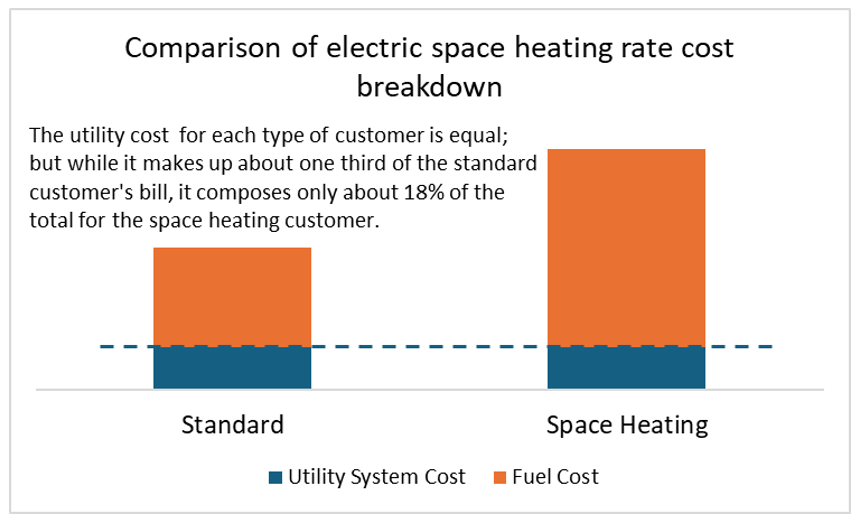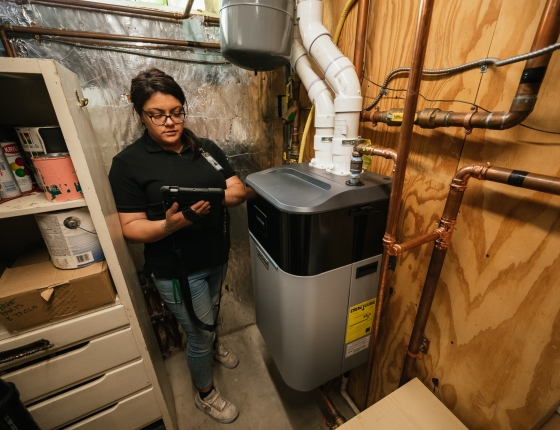Electric space heating technologies have advanced significantly in recent years, making electric space heating options more efficient, affordable, and effective in cold climates. Today, electric air source heat pumps (ASHPs) can deliver three to four times more heat energy to a home than the electrical energy they consume. This is possible because a heat pump moves heat from one location to another rather than generating heat directly, as combustion and electric resistance heating technologies do. Based on our field tests, cold climate ASHP models can deliver space heating down to outdoor temperatures of -13 degrees Fahrenheit.
As greenhouse gas emissions of Minnesota’s electric system continue to decline, becoming emissions-free by 2040, electric space heating is a powerful tool for decarbonizing our state’s economy. As mentioned in a prior blog post on natural gas decarbonization, about two-thirds of Minnesotans heat with natural gas in the winter and greenhouse gas emissions from natural gas have risen over 32% since 2005. As Minnesota seeks to decarbonize, reducing natural gas consumption for space heating is critical.
Unfortunately, under current rate structures, space heating with electricity can significantly increase customers’ energy bills. Historically natural gas has been a less expensive fuel source than electricity for home heating, posing a major barrier for customers to electrify some or all their home heating.
Special electric space heating rates are an important step toward deploying efficient electric space heating technologies. Lower electric space heating rates would recognize the added load of electric space heating customers and the system benefits of electric and dual fuel space heating loads, enabling cost-effective operation. Residential electric space heating rates reduce operating costs for efficient and low-emissions residential heating technologies like ASHPs, making them a feasible and cost-effective option for Minnesota customers.
Electric space heating rates offer a lower cost of electricity to customers who are heating using electricity. This cost differential is important for several reasons:
- Electric space heating customers have much higher electric loads than the average Minnesota customer and pay far more than their fair share of the fixed electric system costs at a standard rate.
Electric utility bills are composed primarily of two parts: the cost of the electricity (often called the fuel charge) and utility's rate. Each customer pays based on the total amount of electricity consumed. Utility rates are added on top of the cost of electricity to allow the utility to recover the costs of the infrastructure (transmission, distribution, and utility-owned generation assets), as well as the costs the utility incurs to operate the system and serve its customers. Much of the utility's rate comprises costs that don't change based on how much electricity is consumed or sold.
In the simplest terms the utility determines its rate by estimating the total cost of the system and operations for each customer class (residential, commercial, and industrial) and spreading that cost evenly across it. In Minnesota, most utility costs are recovered on a volumetric basis through rates, so the utility must divide the annual utility cost per customer by the average annual electric consumption for that customer class to get the appropriate rate per unit of electricity (kWh). This approach results in a fair distribution of utility costs across customers if the customers in that class use electricity similarly. This approach becomes less fair when some customer in the class use significantly more or less energy. In that case, some customers may pay much more than their fair share of utility system costs, while others pay far less.
Residential electric space heating customers, including dual fuel space heating customers that use an electric heat pump as their primary heating source with a gas furnace for back-up heat, use between 160 to 700 percent the electricity of a standard residential customer with a gas furnace and standard air conditioner. As such, if residential customers with electric space heating pay the same rate as a standard residential customer, they would pay up to seven times more for utility system costs, far more than their fair share.
It is critical that utilities offer electric space heating rates that recognize the added load of electric space heating customers, to ensure that these customers don’t overpay for the electric system and operations. While electric space heating customers will pay more for the electricity they use in terms of fuel charges, and thus have higher overall electricity bills, they should contribute the same total amount to utility system fixed costs and general operations.

Illustrative only
- The space heating rate enables cost-effective efficient fuel switching, in this instance, the customer choice to switch from gas to electric space heating. Customers will be unlikely or unable to switch from natural gas space heating to electric space heating if the operating costs to do so are too high.
- Electric space heating increases the load for electric utilities, especially at times of the year when low-cost renewables are most plentiful. First, electric space heating increases overall electric load. This allows the utility to spread its fixed costs across more sales, bringing down rates for all customers over time. Second, customers heating with an electric heat pump provide many additional benefits to the electric system. ASHPs provide space cooling far more efficiently than a standard air conditioner, reducing summer peak demand. ASHPs, when paired with a back-up gas furnace, use more electricity in the shoulder seasons (fall and spring), when Minnesota’s wind resources are most productive. Wind is our lowest-cost electricity resource (next to energy efficiency), so adding more low-cost wind to our resource mix reduces the fuel costs for all customers, too. Finally, heat pumps paired with a gas furnace back-up don’t contribute to or increase winter peak demand because the gas furnace runs during the coldest hours of the winter instead of the electric heat pump.
At CEE, we believe it is important to offer reduced electric space heating rates to customers to recognize the added space heating load and encourage the use of efficient electric HVAC systems that reduce emissions and benefit the grid. New proposals for electric space heating rates, like the one recently released by Xcel Energy in its Time of Use Rate Design petition (filed in Minnesota Public Utilities Commission docket 23-524) will strengthen the value proposition for electric heat pumps for customers who have natural gas heat. Electric space heating rates are a critical part of the solution as Minnesota seeks to become more efficient, reduce greenhouse gas emissions, increase access to clean energy, and affordably and equitably provide heating services in the winter.
